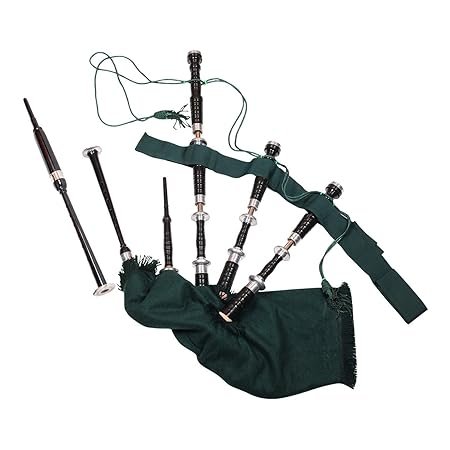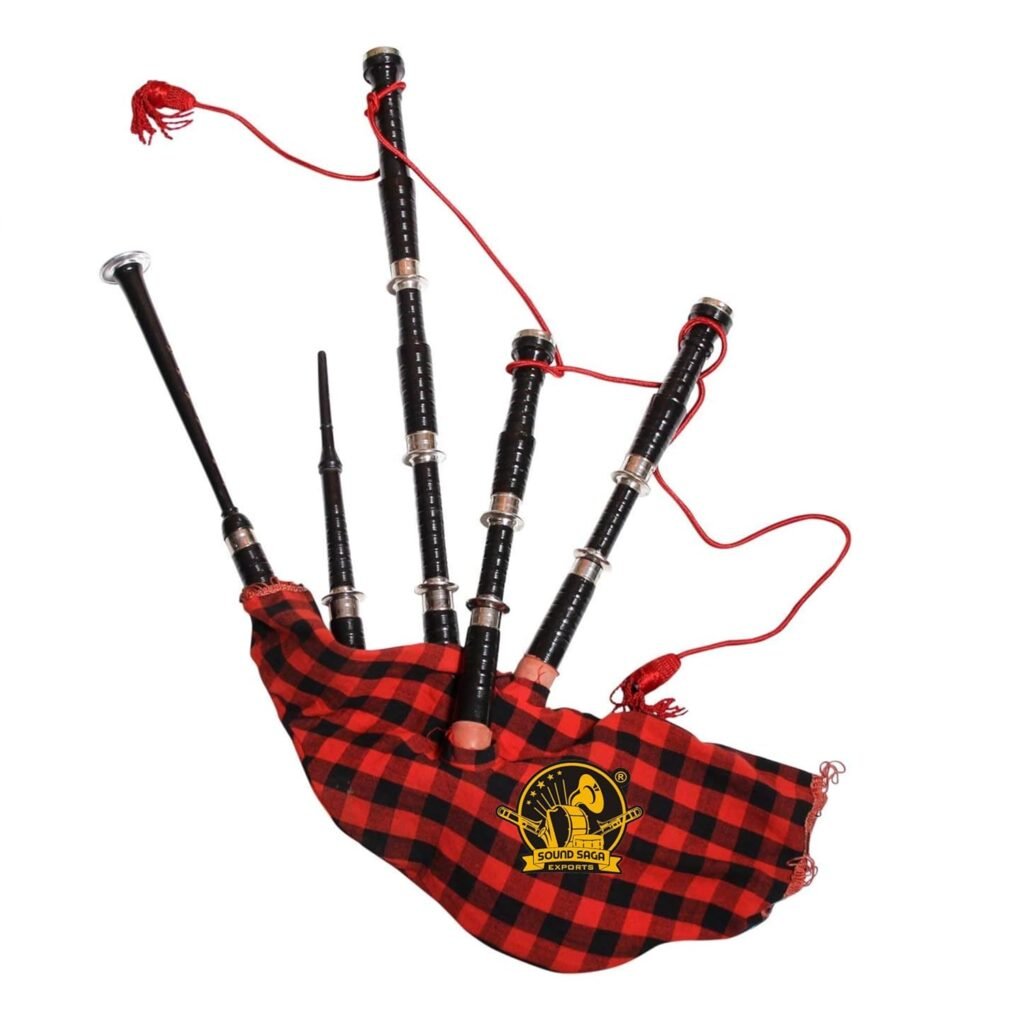a guide to bagpipes musical instruments
A Guide to Bagpipes Musical Instruments
Bagpipes are more than just musical instruments; they are symbols of cultural heritage and a rich tradition that spans centuries. From the rolling highlands of Scotland to the bustling cities of India, bagpipes evoke a sense of grandeur and pride. In this A Guide to Bagpipes Musical Instruments, we’ll explore everything you need to know about bagpipes, their components, types, and how they’ve become a staple in various musical and ceremonial settings.
What Are Bagpipes? ( A Guide to Bagpipes Musical Instruments )
Bagpipes are wind instruments consisting of a bag that supplies a continuous flow of air to the pipes. The musician inflates the bag and uses it to maintain a steady sound, creating a harmonious blend of melodies and drones.
A Brief History of Bagpipes (A Guide to Bagpipes Musical Instruments )
The origins of bagpipes can be traced back over a thousand years. While they are most famously associated with Scotland, evidence suggests they were used in ancient civilizations such as Rome and Egypt. Over time, bagpipes became integral to European and Middle Eastern musical traditions, eventually finding their way to India and other parts of the world.
A Guide to Bagpipes Musical Instruments
Components of Bagpipes

| Colour | Black and Green |
| Brand | SM’SAI MUSICALS |
| Instrument Key | C Major |
| Material | Wood |
| Style | Traditional |
About this item
- Material : Wood
- Size (L x W x H) 5cm x 5cm x25 cm.
- Colour : black and green
- Real instrument and plays good
- Great Quality for best sound and pitch effect
________________________________________________________________________________________________________________
Special Design Rosewood Bagpipe with Gig bag (RED BLACK)
Special Design Rosewood Bagpipe with Gig bag

| Colour | RED BLACK |
| Brand | SOUND SAGA |
| Material | Rosewood |
| Style | Classic |
| Finish Type | Polished |
- Bag
The bag acts as a reservoir to hold air, enabling a continuous sound. Traditional bags were made of animal hides, but modern versions often use synthetic materials. - Chanter
The chanter is the melody pipe that the player uses to produce notes. It typically has finger holes, much like a flute or recorder. - Drones
Drones are pipes that produce a constant harmonic sound. Most bagpipes have three drones, but the number can vary depending on the type. - Blowpipe
The blowpipe is used to inflate the bag. Modern designs often include a valve to prevent air from escaping.
A Guide to Bagpipes Musical Instruments- Types of Bagpipes
- Great Highland Bagpipes
The most iconic type, commonly used in Scottish ceremonies and military bands. - Uilleann Pipes
Traditional Irish bagpipes known for their softer, more intricate sound. - Northumbrian Smallpipes
Originating from Northern England, these pipes have a closed-ended chanter that produces a staccato sound. - Indian Bagpipes
Widely used in ceremonial events and military bands in India, combining traditional sounds with local cultural influences.
A Guide to Bagpipes Musical Instruments: Cultural Significance of Bagpipes
Bagpipes are deeply rooted in cultural and ceremonial traditions. They are used in military processions, weddings, funerals, and parades, symbolizing honor, pride, and heritage. In Scotland, the sound of bagpipes is synonymous with national pride, while in India, they have been adopted into the military and cultural fabric.

A Guide to Bagpipes Musical Instruments
Hey, have you ever heard that haunting drone cutting through the air at a parade or wedding, and thought, “Wow, what is that sound?” That’s the magic of bagpipes, my friend! These aren’t just any musical instruments; they’re like living pieces of history that stir the soul with their unique blend of melody and harmony. Bagpipes have been around for ages, captivating people from misty Scottish hills to bustling Indian streets.
But what makes them so special? Well, unlike a guitar or piano, bagpipes produce a continuous sound thanks to their clever design—think of it as a musical marathon runner that never needs to pause for breath. In this guide, we’ll dive deep into everything bagpipes, from their ancient roots to how you can start playing one yourself.
Whether you’re a total newbie curious about the buzz or a music lover looking to expand your horizons, stick around. We’ll chat like old pals sharing stories around a campfire, uncovering why bagpipes aren’t just instruments—they’re cultural icons that connect us to traditions worldwide. Imagine holding one in your hands; that rush of air turning into timeless tunes. Exciting, right?
Bagpipes stand out in the world of music because they blend wind instrument vibes with something almost orchestral. You blow air into a bag, squeeze it out through pipes, and voila—music that can make you march proudly or weep softly. They’re versatile too, popping up in folk, military, and even rock scenes. But don’t worry if it seems intimidating; by the end of this read, you’ll feel like you’ve got a solid grip on these fascinating beasts. Let’s kick things off with where it all began.
A Guide to Bagpipes Musical Instruments: The History of Bagpipes
Bagpipes didn’t just pop up out of nowhere—they’ve got a backstory richer than a double espresso. Picture this: thousands of years ago, folks were already tinkering with reed instruments, evolving them into what we know today. It’s like tracing your family tree back to ancient times, full of surprises and migrations.
A Guide to Bagpipes Musical Instruments: Ancient Origins
Way back, around 1000 BCE, carvings from the Middle East show early versions of bagpipes—simple reed pipes without the bag, but the idea was there. Think of them as the great-grandparents of modern pipes, used in places like Egypt and Rome. Nero, that infamous Roman emperor, supposedly played a bagpipe-like instrument, not the fiddle as legends say.
These early forms were basic, made from natural materials like hollow reeds or animal bones, and they spread through trade routes. In ancient Greece, something called the askaulos combined a reed pipe with a bladder, hinting at the bag concept.
Why did they catch on? Because they provided that steady, droning sound perfect for dances and ceremonies, like a heartbeat keeping the rhythm alive. Fast forward, and by the first century AD, Romans were using them to rally troops—imagine the psychological boost of that unrelenting wail on the battlefield!
A Guide to Bagpipes Musical Instruments: Evolution in Europe and Beyond
As centuries rolled on, bagpipes hitched rides across continents, morphing with each culture. In Europe, by the 9th to 13th centuries, they became folk staples from Spain to Russia, often for lively dances since their continuous tone meant no breaks.
Scotland claims the spotlight, with the Great Highland Bagpipe emerging around the 15th century, tied to clans and battles. But Ireland, France, and even India got in on the action—Indian mashak pipes, for instance, jazz up weddings with their single drone vibe. The military angle exploded; bagpipes replaced trumpets for their piercing carry over noise.
Piping families in the Highlands kept traditions alive through wars, including both World Wars. Then came modern twists like electronic versions in the 1960s, making them accessible without the huff and puff. Today, they’re symbols of heritage, played at funerals, parades, and festivals. It’s like bagpipes are cultural nomads, adapting yet staying true to their roots. Who knew such a quirky instrument had such a globe-trotting tale?
A Guide to Bagpipes Musical Instruments- Anatomy of a Bagpipe
Alright, let’s dissect this thing—figuratively, of course. Understanding a bagpipe’s parts is like knowing the ingredients in your favorite recipe; it makes the whole experience tastier. At its core, a bagpipe is a wind instrument with reeds, but its setup is what sets it apart.
A Guide to Bagpipes Musical Instruments- Key Components
Every bagpipe has essentials that work in harmony, pun intended. The bag acts as the air tank, reeds vibrate to make sound, and pipes channel it all out. Materials range from traditional animal skins and woods to modern synthetics, making them durable for today’s players. It’s a clever system where you supply the air, and the instrument handles the rest, creating that signature drone that’s both mesmerizing and mighty.
The Bag and Blowpipe
The bag is the heart—traditionally sheepskin or goatskin, now often synthetic for ease. You inflate it via the blowpipe, a tube with a valve so air doesn’t escape when you breathe. Squeeze the bag under your arm, and it pushes air steadily through the pipes. Think of it as a balloon that never deflates fully, keeping the music flowing without gasps. Modern bags have zips for easy access or moisture control to handle sweaty sessions. Without a good bag, your pipes would sputter like a car running on fumes.
Chanter and Drones
The chanter is where the melody happens—a pipe with finger holes like a recorder, but with a double reed for that sharp tone. You play notes by covering and uncovering holes, creating tunes over the constant hum. Drones are the backup singers—usually three long pipes that produce steady notes, harmonizing with the chanter. They’re tuned just right, adding depth like bass in a band. Reeds inside vibrate with air, and getting them right is key; too stiff, and it’s a struggle, too soft, and it’s weak. Together, they make bagpipes sing like no other instrument.
A Guide to Bagpipes Musical Instruments- Types of Bagpipes Around the World
Bagpipes aren’t one-size-fits-all; they’re a family with cousins everywhere. Each type has its flavor, suited to different tunes and settings. It’s like coffee—espresso for one mood, latte for another.
Great Highland Bagpipes
These are the rockstars, the ones you picture with kilts and parades. Known as piob mhòr, they’ve got three drones and a loud, bold sound perfect for outdoors. Made from blackwood or synthetic, they’re Scottish icons used in military bands and ceremonies. Why so popular? Their volume cuts through crowds like a siren, evoking pride and power. If you’re into marches, this is your go-to.
Uilleann Pipes
Irish charm in pipe form! Uilleann means “elbow,” since you pump bellows with your arm, not your mouth—easier on the lungs. They have regulators for chords, adding complexity like a mini organ. Softer than Highlands, they’re great for indoor sessions, producing intricate melodies. Think of them as the thoughtful poet to the Highland’s warrior.
Smallpipes and Border Pipes
Smallpipes are the chill version—bellows-blown, quiet, ideal for home practice or folk groups. Scottish smallpipes have a sweet tone, while Northumbrian ones add staccato flair with closed chanters. Border pipes blend Scottish and English styles, mouth-blown with a bright punch. They’re like acoustic guitars—versatile, portable, and less intimidating for beginners.
A Guide to Bagpipes Musical Instruments- Other Global Variations
Don’t stop at Europe! Gaidas from the Balkans have big bags and one drone, rocking festivals. Mashak in India and Pakistan jazz up weddings with single reeds. Spanish gaitas and French cornemuses add their twists, from keyed chanters to bellows. Each reflects local culture, proving bagpipes are world travelers, adapting like chameleons to new homes.
How to Play Bagpipes: A Beginner’s Step-by-Step Guide
Ready to pipe up? Learning bagpipes is like training for a sport—patience pays off, and the rewards are epic. Don’t fret; anyone can start with basics.
Getting Started with a Practice Chanter
Kick off with a practice chanter—it’s the melody pipe alone, quiet and cheap, around $20-100. Grab a tutor book or online lessons. Hold it like a recorder, blow steadily, and learn the scale: nine notes from low G to high A. Practice daily, 15-30 minutes, focusing on finger placement. It’s your foundation, like learning alphabet before writing stories.
A Guide to Bagpipes Musical Instruments- Basic Techniques and Fingerings
Master gracenotes—quick finger flicks adding flair, like spices in cooking. Work on embellishments: strikes, doublings, throws. Control breath; steady pressure is key. Use a mirror to check posture—stand tall, elbows relaxed. Start simple tunes like “Scotland the Brave.” Join a class or band for feedback; it’s motivating, like having workout buddies.
A Guide to Bagpipes Musical Instruments- Transitioning to Full Bagpipes
After 6-12 months on chanter, add drones and bag. Inflate via blowpipe, squeeze with arm while fingering. Balance air flow—too much, it squeals; too little, it dies. Tune drones to match chanter. Practice marching to build stamina. It’s challenging but thrilling, like riding a bike without training wheels. Soon, you’ll play full sets!
A Guide to Bagpipes Musical Instruments- Famous Bagpipe Tunes and Their Meanings
Tunes are the soul of bagpipes—each tells a story. “Scotland the Brave” pumps patriotism, like a national pep talk. “Amazing Grace” tugs heartstrings at memorials, symbolizing hope. “The Skye Boat Song” recalls historical escapes, slow and sorrowful. “Highland Cathedral,” a modern gem, graces weddings with majesty. Learning these connects you to centuries of emotion.
A Guide to Bagpipes Musical Instruments- Bagpipes in Modern Music and Culture
Bagpipes aren’t stuck in the past—they rock modern scenes! In movies like “Braveheart,” they amp up epic battles. TV shows like “Outlander” weave them into history. Bands like Red Hot Chilli Pipers fuse them with rock, proving versatility. Pop culture loves the drama; even comedies poke fun. Today, they’re at festivals, blending with electronics for fresh sounds. Like vinyl’s comeback, bagpipes thrive in 2025’s diverse music world.
Maintenance and Care Tips for Your Bagpipes
Keep your pipes happy, and they’ll sing sweetly. Maintenance is like car tune-ups—regular and essential.
A Guide to Bagpipes Musical Instruments- Daily Maintenance
After playing, dry everything: remove chanter, cap reeds, unzip bag to air out. Wipe bores with pull-through cloths, check joints for airtightness. Hemp threads if loose. Store in a case away from heat. It’s quick, preventing mold like brushing teeth stops cavities.
A Guide to Bagpipes Musical Instruments- Seasonal Care
Every few months, season the bag with oils if leather, or check synthetics for wear. Oil wood bores to prevent cracks, especially in dry winters or humid summers. Replace reeds as needed—cane ones seasonally. Full servicing yearly by pros. Adapt to weather; humidity affects tuning, like how seasons change your wardrobe.
A Guide to Bagpipes Musical Instruments- Famous Bagpipe Players You Should Know
Meet the legends! Willie McCallum, a competition king, wows with precision. Stuart Liddell brings innovation to Inveraray band. Roddy MacLeod’s tone is gold. Gordon Duncan revolutionized with bold compositions. Irish star Patrick D’Arcy masters uilleann intricacies. These folks inspire, like rock stars of piping—check their videos for motivation.
A Guide to Bagpipes Musical Instruments- Buying Your First Bagpipe: Tips and Considerations
Dipping into buying? Start simple. Beginners, go for synthetic sets under $1000—durable, weather-proof. Brands like R.G. Hardie or McCallum offer quality. Test for comfort; bag size matters. Add accessories: practice chanter, reeds, case. Buy from reputable shops for guarantees. Used? Inspect carefully. It’s an investment, like picking a bike—fits right, rides smooth.
Diving deeper into the allure, bagpipes captivate because they demand body and soul. Your arm pumps, fingers dance, breath fuels—it’s a full workout wrapped in melody. Ever wondered why pipers march? It builds rhythm and stamina, turning practice into performance art. In clans, pipers led charges, their drones boosting morale like a battle cry.
Today, bands compete globally, judging tone, technique, unity. For kids, starting young builds discipline, like Seumas Coyne piping professionally at 12. Adults? It’s never too late; online tutorials abound in 2025.
Types expand: cauld wind pipes use bellows for delicate reeds, suiting chamber music. Gaidas’ inside-out hides combat moisture cleverly. Mashak’s festival vibes remind us music unites cultures. Anatomy tweaks: some have multiple chanters for duets, others keys for chromatics. Playing evolves—overblow for octaves, sliding for bends, adding expressiveness.
Tunes vary: marches for parades, airs for laments, reels for dances. “Highland Cathedral” from 1982 shows modernity. In pop, AC/DC’s Bon Scott piped roots, Phil Collins dabbled. Movies amplify: “Titanic’s” farewell scene tugs with pipes. Culture-wise, Highland Games showcase athletic piping—imagine tossing cabers to drones!
Maintenance hacks: use moisture traps for wet blowers, tuning apps for precision. Famous players like Jack Lee dominate solos, Finlay Johnston innovates. Buying? Budget for lessons—$50/session accelerates. Synthetics resist cracks, blackwood warms tone. Heritage sets honor history, pricey but heirlooms.
More on history: biblical mentions hint at “symphonia” as pipes. European art depicts them in feasts, wars. Modern resurgence in folk revivals keeps traditions alive. Playing tips: warm-up fingers, record sessions for critique. Communities like Reddit share advice, fostering growth.
Anatomy details: stocks secure pipes, valves prevent backflow. Reeds? Cane traditional, synthetic reliable. Types: Northumbrian’s keys add range. Uilleann’s regulators chord like piano. Smallpipes suit apartments, less neighbor complaints.
Tunes’ depths: “Amazing Grace” adopted universally, transcending origins. Culture: electronic pipes gig without fatigue. Maintenance: bore oil monthly, hemp wax for seals. Players: G.S. McLennan classics endure. Buying: bundles save, include tutors.
Expanding, bagpipes symbolize resilience—banned post-1745 Jacobite rising, yet survived. In 2025, AI composes tunes, but human touch reigns. Playing builds confidence, like public speaking with music. Join bands for camaraderie, travel competitions.
A Guide to Bagpipes Musical Instruments
Wrapping up our bagpipe adventure, these instruments are more than wood and reeds—they’re bridges to history, culture, and personal expression. From ancient battlefields to modern stages, bagpipes continue to inspire with their unmistakable voice. Whether you pick one up or just appreciate from afar, they’ve got a way of sticking in your heart. So, go ahead, explore, play, and let the drones carry you away. Who knows? You might just find your new passion.
A Guide to Bagpipes Musical Instruments: FAQs
What makes bagpipes different from other wind instruments? Bagpipes stand out with their air reservoir bag and constant drone pipes, allowing uninterrupted sound, unlike flutes or trumpets that need breath pauses.
How long does it typically take for a beginner to learn basic bagpipe tunes? Most beginners master simple tunes like “Scotland the Brave” in 6-12 months with regular practice on a chanter, then transition to full pipes.
Are synthetic bagpipes as good as traditional wooden ones? Synthetic ones are durable and weather-resistant, great for beginners, while wooden like blackwood offer richer tones for pros—it’s about your needs.
Can bagpipes be played in different musical genres beyond traditional folk? Absolutely, they’ve rocked in bands, movie scores, and even electronic mixes, showing their versatility across rock, pop, and classical fusions.
What’s the best way to store bagpipes when not in use? Keep them in a padded case, unzipped for air circulation, away from heat or direct sun, and remove the chanter to prevent moisture buildup.
A Guide to Bagpipes Musical Instruments: Learning to Play Bagpipes
- Choosing the Right Bagpipe
Beginners should start with practice chanters to master the basics before transitioning to full-sized bagpipes. - Mastering the Basics
Learning the correct posture, breathing techniques, and finger placement is crucial. - Joining a Bagpipe Band
Playing in a band can enhance your skills and introduce you to a supportive community of musicians.
A Guide to Bagpipes Musical Instruments- How to Maintain Your Bagpipes
- Regular Cleaning
Clean the chanter, drones, and bag regularly to prevent moisture buildup. - Replacing Reeds
Reeds are vital for sound quality and should be replaced when worn out. - Storing Properly
Always store your bagpipes in a cool, dry place to protect them from damage.
A Guide to Bagpipes Musical Instruments: Where to Buy Bagpipes
Bagpipes can be purchased from specialized shops, online stores, or directly from makers. Look for trusted sources that offer high-quality instruments and accessories. Popular brands include McCallum Bagpipes, RG Hardie, and Dunbar Bagpipes.
Why Bagpipes Are Unique
Bagpipes stand out due to their ability to produce a continuous, harmonic sound. Their distinctive tone, cultural significance, and versatility make them a timeless musical instrument cherished by players worldwide.
A Guide to Bagpipes Musical Instruments
Bagpipes are more than instruments; they are a bridge between music, culture, and tradition. Whether you’re a beginner looking to learn or a seasoned musician, understanding the intricacies of bagpipes enhances your appreciation of this iconic instrument.
By investing in quality instruments and practicing regularly, you can unlock the full potential of bagpipes and contribute to their enduring legacy.
A Guide to Bagpipes Musical Instruments: FAQs
- What are bagpipes made of?
Bagpipes are traditionally made of wood, animal hide, and cane reeds, but modern versions often use synthetic materials. - How hard is it to learn bagpipes?
Bagpipes require dedication and practice but are manageable with the right guidance and tools. - Where can I buy authentic bagpipes?
You can purchase bagpipes from specialized shops, online stores, or directly from bagpipe makers. - Are there different types of bagpipes?
Yes, popular types include Great Highland Bagpipes, Uilleann Pipes, Northumbrian Smallpipes, and Indian Bagpipes. - What are bagpipes used for?
Bagpipes are used in ceremonies, parades, military events, and musical performances.
Tags: A Guide to Bagpipes Musical Instruments,Bagpipe instrument guide, How to play bagpipes, Bagpipe types and history, Bagpipe components explained, Learn about bagpipes, Different types of bagpipes, How bagpipes work, Bagpipe playing techniques, Scottish bagpipes, Bagpipe maintenance guide, Best bagpipes for beginners, Traditional bagpipes, Bagpipe instruments for sale, Bagpipes cultural significance, Bagpipe accessories, Bagpipe sound and music, Bagpipe tutorials,Bagpipe instrument parts, Bagpipe care and repair, Popular bagpipe brands.



